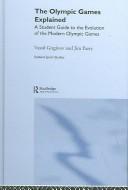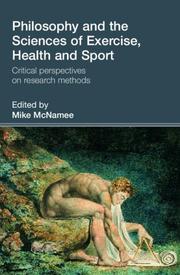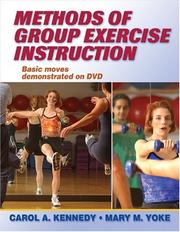| Listing 1 - 4 of 4 |
Sort by
|

Abstract | Keywords | Export | Availability | Bookmark
 Loading...
Loading...Choose an application
- Reference Manager
- EndNote
- RefWorks (Direct export to RefWorks)
796.032 --- 796 <09> --- 796.062 --- 796.034 --- Olympische gedachte. Olympische beweging --- Lichamelijke opvoeding. Sport en spel--Geschiedenis van ... --- Organisatie, management en marketing van sport en recreatie --- Aangepast sporten. Adapted physical activity --- 796 <09> Lichamelijke opvoeding. Sport en spel--Geschiedenis van ... --- 796.032 Olympische gedachte. Olympische beweging --- 796.034 Aangepast sporten. Adapted physical activity --- 796.062 Organisatie, management en marketing van sport en recreatie --- Olympics --- Olympic ideal --- History --- Philosophy --- Lichamelijke opvoeding. Sport en spel--Geschiedenis van .. --- Lichamelijke opvoeding. Sport en spel--Geschiedenis van . --- Lichamelijke opvoeding. Sport en spel--Geschiedenis van
Article
Year: 2005
Abstract | Keywords | Export | Availability | Bookmark
 Loading...
Loading...Choose an application
- Reference Manager
- EndNote
- RefWorks (Direct export to RefWorks)
The body weight gain, and food and water intake of the rats were measured. During weeks 3 or 4, home cage behaviour, urinary cortiosterone/ creatinine ratios (CO/CR), and muscle strength on an inclined plane, were measured. Enzyme activities and glycogen content were measured in tissue samples from m. triceps brachii taken after euthanization at the end of the study. There were no significant differences between groups for food and water intake, but PH rats weighed 14% less than SI rats after 4 weeks, and PH rats also had a more diverse behavioural pattern than SI rats. PH rats had significantly higher oxidative capacity (28% more citrate synthase (CS)) and greater glycogen content (28%) in their muscle samples than SI rats. The PH rats performed significantly better on the inclined plane, both in the muscle strength test (mean angle 75 +/- 0.5degrees for PH rats and 69 +/- 0.4degrees for SI rats) and the endurance strength test (mean time 233 +/- 22 s for PH rats and 73 +/- 14 s for SI rats). There was a negative correlation between body weight and results on the inclined plane for the PH rats. There were no significant differences between housing types with respect to CO/CR ratios. In conclusion, the large pen represents an environment that stimulates physical activity and more varied behaviour, which should be beneficial for the welfare of the animal The cage systems commonly used for housing laboratory rats often result in sedentary and overweight animals, as a consequence of restricted opportunities for physical activity combined with ad libitum feeding. This can have implications both for animal well-being and for the experimental outcome. Physical activity has several known positive effects on health and lifespan, and physical fitness might therefore be incorporated into the animal welfare concept. The aim of this study was to investigate if and how pen housing affects the physical activity and fitness of rats. Thirty-two juvenile male Sprague-Dawley rats were randomly assigned to two different housing systems for a 4-week period. Sixteen rats were kept individually in standard Makrolon type III cages (42 X 26 X 18 cm) furnished with black plastic tubes (singly-housed, SI). The remaining rats were kept in groups of eight, housed in large floor pens (150 X 210 cm), which were furnished with various objects to increase environmental complexity (pen-housed, PH).
Activity. --- Ad-libitum. --- Animal welfare. --- Animal-welfare. --- Animal. --- Animals. --- Behaviour. --- Body weight. --- Body-weight. --- Cage. --- Cages. --- Corticosterone levels. --- Corticosterone. --- Cs. --- Depression. --- Endurance exercise. --- Endurance. --- Enrichment. --- Environment. --- Environmental enrichment. --- Enzyme-activities. --- Feeding. --- Female rats. --- Fiber types. --- Floor. --- Food. --- Glycogen. --- Group. --- Health. --- Housing system. --- Housing type. --- Housing. --- Increase. --- Kept. --- Laboratory animals. --- Laboratory rat. --- Laboratory rats. --- Laboratory. --- Level. --- Male. --- Muscle enzyme activity. --- Object. --- Objects. --- Pattern. --- Pen. --- Performance. --- Ph. --- Physical activity. --- Physical-activity. --- Physical. --- Rat. --- Rats. --- Resistance. --- Skeletal-muscle. --- Sprague-dawley rats. --- Sprague-dawley. --- Strength. --- System. --- Systems. --- Test. --- Time. --- Vascular adaptations. --- Weight gain. --- Weight. --- Welfare. --- Well-being.

ISBN: 0415353408 0415300169 9786610289721 1134421443 0203506006 1280289724 9780203506004 6610289727 9780415300162 9781134421442 9781134421398 1134421397 9781134421435 1134421435 9780415353403 9781280289729 Year: 2005 Publisher: Abingdon, Oxon Routledge
Abstract | Keywords | Export | Availability | Bookmark
 Loading...
Loading...Choose an application
- Reference Manager
- EndNote
- RefWorks (Direct export to RefWorks)
Philosophy and the Sciences of Exercise, Health and Sport is a unique interdisciplinary study that calls on researchers in these disciplines to reflect more critically on the nature and aims of scientific enquiry. In doing so, the book questions the underlying assumptions and development of science itself. Written by a range of internationally respected philosophers, scientists and social scientists, each chapter addresses a key issue in research methodology. Questions asked by the authors include: Do natural and social scientists need to understand the philosophy of science? Are statistics misused in sport and exercise science research? Is sport science research gender-biased? How do external and commercial interests skew professional guidelines in health and sport research? Should scientists focus their attention on confirmation of theories, or on attempts to falsify them? Philosophy and the Sciences of Exercise, Health and Sport serves notice to exercise, health and sport researchers to think more philosophically about their subject and its scientific bases. It is essential reading for postgraduate researchers seeking to establish a sound theoretical foundation for their work.
Sports sciences. --- Sports --- Sciences du sport --- Philosophy. --- Philosophie --- 796.011 --- Filosofie van de lichaamscultuur en sport --- 796.011 Filosofie van de lichaamscultuur en sport --- Sports sciences --- Exercise --- Recreation & Sports --- Social Sciences --- Research --- Methodology --- Health aspects --- Methodology. --- Physical activity --- Warm-up --- Workouts (Exercise) --- Field sports --- Pastimes --- Recreations --- Sciences, Sports --- Sport sciences --- Recreation --- Athletics --- Games --- Outdoor life --- Physical education and training --- Science --- Health --- Health aspects&delete& --- Research&delete& --- E-books

ISBN: 073604907X Year: 2005 Publisher: Champaign Human kinetics
Abstract | Keywords | Export | Availability | Bookmark
 Loading...
Loading...Choose an application
- Reference Manager
- EndNote
- RefWorks (Direct export to RefWorks)
Methods of Group Exercise Instruction is the most comprehensive research-based book available for health and fitness professionals who want to learn how to lead effective group exercise classes. It describes the methodology required for setting up classes, how to create effective teaching progressions, and how to choreograph and program to music. More than 15 different class formats are covered, including high/low impact, step, kickboxing, indoor cycling, and water exercise. No other text goes into such detail or covers many of the unique class formats in this book, such as water exercise and cycling. (Bron: covertekst)
796.015.57 --- 372.879.6 --- 052328.jpg --- Fitness --- Aerobe en anaerobe training --- Lichamelijke opvoeding. Didactiek van de lichamelijke opvoeding --(niet-universitair onderwijs) --- 372.879.6 Lichamelijke opvoeding. Didactiek van de lichamelijke opvoeding --(niet-universitair onderwijs) --- 796.015.57 Aerobe en anaerobe training --- Exercise personnel --- Exercise --- Physical education and training --- Physical activity --- Warm-up --- Workouts (Exercise) --- Health --- Exercise specialists --- Allied health personnel --- Certification --- Study and teaching
| Listing 1 - 4 of 4 |
Sort by
|

 Search
Search Feedback
Feedback About UniCat
About UniCat  Help
Help News
News